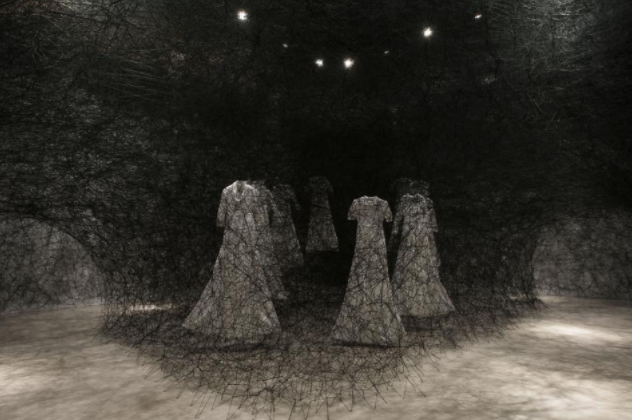Contemporary Japanese Art
What?
So far this series has taken you through a range of traditional Japanese arts, giving you insight into the depth of the country’s history and culture. Just like the richness you can find in traditional and ancient Japanese arts, Japanese contemporary art is diverse and transformative. Pop-up contemporary art installations can be found throughout all major cities in Japan and feature diverse artists and inspirations. In this post, I will focus on Naoshima, also known as “art island,” and the works of Japanese contemporary artist Chiharu Shiota.

“Pumpkin” by Yayoi Kusama, one of the many modern pieces found on Naoshima.
Image Credit: Lorrie Hayman
Naoshima is like no other island on earth. The designer transformed it into a living and breathing museum by incorporating the natural landscape, while featuring some of the most distinguished artists of all time. Yayoi Kusama’s “Pumpkin” sculptures dot the island and five of Claude Monet’s painting series “Water Lilies” are on display in the island’s Chichu Art Museum.
Why?
Naoshima island used to be a humble fishing port island. However, in 1987 Benesse Holdings, Inc. – a Japanese education and publishing group- chose to showcase their extensive art collection there, a move they believed would also breathe new life into the once vibrant port. They bought a big area of land on Naoshima (a pretty small island -only 5.5 square miles) and they hired globally renowned architect Tadao Ando to design the project. Over two decades, Ando built breathtaking museums and created unique spaces to house art from the likes of Monet and Andy Warhol, as well as many other famous and not so famous artists.
Whether it’s on Naoshima, displayed in a museum or on a busy city street, contemporary art stretches the imagination. Chiharu Shiota’s work is a perfect example. As a performance and installation artist, her work explores memory, dreams and reality. The central theme is the confrontation of anxiety. She currently lives in Berlin, but her work is often featured in exhibitions around the world, including The National Museum of Modern Art in Tokyo, Japan.
Shiota’s work usually features black or red threads surrounding ordinary objects to give a sense of them being close, yet impossibly far away. The threads also create the feeling that paint is suspended in mid-air. In her piece “Uncertain Journey,” Shiota wanted to “emphasise this feeling of travelling with nowhere to go whilst alluding to a search for a sense of belonging.”
How?
Think about why you want to create art, rather than what you want to make. This will help you focus your inner artist and help you make your own unique creations. Anyone can create art. Grab some pens, pencils, thread or clay and start!
I hope you can use your newfound knowledge of Naoshima Island and Chiharu Shiota’s artwork to help you begin.
Here’s some more inspiration:
Show us what you come up with. And don’t forget to share your thoughts on this post by using the form below or tagging us @ArtsmithNY on Twitter, Instagram, and Facebook. Use the hashtag #ArtsmithJABS.
Submit Comments or Artwork
Tell us what you think about the blog series or send us pictures or video of your practice. We’ll check them out and maybe we’ll post them for others to see!





